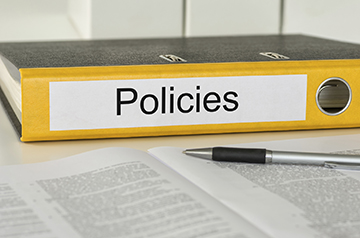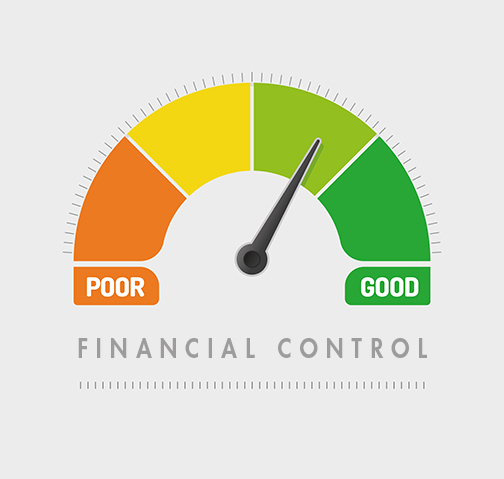Call Don today: 951-533-4966
Blog
Don Welker's Financial Minute

When a company is first starting out, it is common for the owner/CEO to make nearly all of the decisions. But as a company grows, this approach becomes completely unworkable. Not only is it just too much for one person to tackle, it’s really not the best use of the CEO’s time. Delegating many of the day-to-day decisions to members of lower, middle and upper management becomes a must.
Why establish formal policies and procedures?
Delegation, of course, involves a certain level of risk. How do you ensure that decisions and approvals are made and given in a manner that is consistent with the goals and values of senior management—and in compliance with all applicable laws and regulations—without requiring senior management to be tied up with routine decisions? You establish policies and procedures.
Policies and procedures ensure consistency. They can mean the difference between order and chaos, and compliance and noncompliance. They can also save a great deal of time for everyone involved. After all, when everyone understands the guidelines, decision-making becomes easier.
Establishing appropriate policies and procedures
Depending on the nature of the business, there are a wide variety of policies and procedures to establish. These include:
Sales & pricing – Determining minimum order size and minimum acceptable profit on an order
Extending credit – Evaluating a potential customer’s credit; issuing credit memos
Purchasing – Creating purchase orders; opening accounts with new vendors; approving invoices for payment
Human resources – Establishing employee pay rates and pay increases; allowing use of company vehicles and credit cards
Managerial approvals – Approving expense reimbursements; authorizing corporate travel; signing checks
Legal – Archiving and retaining everything from emails to contracts to financial records
Marketing – Ensuring branding consistency; establishing who is allowed to publicly represent the company to the media
IT – Creating an escalation system; requiring system documentation; ensuring backups take place
Communicating the policies and procedures
It is vital that the policies be written and available for people to see. This can mean putting things in print, uploading them to a corporate wiki, or using some other type of digital document sharing system. For some policies, such as HR-related policies, you’ll want to give each employee a copy in writing and have them sign documentation stating that they’re aware of and have reviewed the policies.
Need help creating policies and procedures that make sense? Give me a call. As a part-time CFO, I’m here for you!

I often speak with business owners who thought they had appropriate cost and financial controls in place, only to be blindsided when they discover they do not. Here are 5 signs that your financial controls might not be adequate:
1. You get an overdraft notice from your bank. This is always bad news. The likely culprits include:
• Higher than expected labor costs, which were not being properly tracked.
• Poor A/R collections, with no controls to recognize problem accounts.
• Data entry errors that made it look like you had more money in the account.
• Bank reconciliations that are not taking place in a timely manner.
2. Inventory numbers in the system don’t agree with the physical count. While some minor variances are often to be expected, these numbers should never be significantly off.
In addition to theft, the likely culprits include:
• Data entry errors – With no controls in place to catch them.
• Receiving shortages – Instead of counting items when received, Receiving assumes the packing slip is correct.
• Shipping errors – With no double-check that the correct items and quantities are being shipped.
3. Inventory values in the system don’t reflect reality. Instead of keeping a detailed perpetual inventory, some companies make the mistake of relying on gross profit percentages to track the value of inventory on hand.
For example, they assume a 35% gross profit margin on everything in category X. If they sell 1000 items from category X for $1.00 each, they subtract $650 from the inventory account. But if the actual gross profit margin on some of these items is not 35%, the inventory values in the system will be incorrect.
4. Profits on completed jobs are lower than expected. This is an indication that better financial controls are needed at every step of the job, from estimating through delivery. A weekly financial dashboard showing a snapshot of how the project is doing on key metrics, coupled with a monthly job cost schedule that drills down into the details, can be very helpful here.
5. You’re paying for people who don’t exist or time that wasn’t worked. This type of fraud is usually discovered when someone notices payroll is higher than expected. Ensuring you have a good time system, and having someone in management other than the Controller review paychecks before they are distributed, can help avoid these situations.
Want to bring in an outside expert to review your financial controls and recommend areas for improvement? Give me a call. As a part-time CFO, this is one of the many services that I provide.

Having a strategic plan in place for your business is the best way to ensure you achieve your goals. After all, if you’re failing to plan, you’re planning to fail. That said, it’s not enough to create a strategic plan. You need to be sure that your strategic plan is not created in a way that will pretty much guarantee it won’t work.
Here are 12 things to watch out for:
1. Having unobtainable goals based on pie-in-the-sky projections.
2. Setting unrealistic budgets that don’t cover actual costs and needs.
3. Failing to create action plans for implementing the strategies and tactics described in the strategic plan.
4. Not getting buy-in from the people who will do or oversee the work.
5. Failing to communicate the vision and strategic objectives to the “rank and file” within the company, or to communicate progress over time.
6. Not assigning responsibilities for each step, and not assigning due dates and timelines.
7. Not planning for the infrastructure needed to accomplish the goals laid out in the plan, such as:
a. People
b. Funds
c. Machinery
d. Physical space
e. Ability to obtain materials, parts or products
f. Production capacity
g. And more
8. Not budgeting for mandated wage increases caused by contractual obligations or increases in the minimum wage.
9. Not doing your homework, such as to determine the actual viability of entering new markets.
10. Not planning for proper marketing and sales support for a new product launch.
11. Not taking steps to avoid scaring customers away with poor customer service, negative press, etc.
12. Taking a “set it and forget it” approach to the strategic plan, rather than following up at regular intervals to ensure it’s being implemented as anticipated.
Want to bring in an outside expert to help you create a strategic plan that makes sense? Give me a call. As a part-time CFO, this is one of the many services that I provide.

The monthly financial reports that most companies issue and review are a great way to keep tabs on how the business is doing. However, for most organizations, reviewing financial data once a month is really not frequent enough. If a problem is brewing, you might not see it until it’s too late to change course.
Financial dashboards, which can be created on a project- or company-wide basis, fill in this gap. Usually set for weekly data, they give management a clear, high-level snapshot of current performance.
Your financial dashboard is used to track things that are easily measured and convertible into a key metric. While they’re most useful if you have a budget to which the numbers can be compared, they’re still helpful even if you don’t.
What to Include on a Company-Based Financial Dashboard
For a company-wide financial dashboard you might want to include the following metrics for that week:
• A/R collections: actual versus budget
• A/R aging: actual versus budget
• A/P payments made: actual versus budget
• A/P aging: actual versus budget
• Payroll expense: actual versus budget
• Full Time Equivalent (FTE) employees: actual versus last week and versus budget (useful for companies where labor fluctuates weekly)
• Cash balances: actual versus last week and versus budget
What to Include on a Project-Based Dashboard
As this will vary greatly based on the industry, I’ll present some possibilities for a construction firm. Here the idea is to track job progress by hours of work completed, and then support that by a measurement of where the project actually stands.
• Actual labor hours
• % of project completed based on labor hours (i.e. actual labor hours divided by total budgeted hours for the project)
• Metric to measure work that was done, actual versus plan. For example, if you’re building a block wall, how many blocks were installed this week? How many blocks will there be in the entire wall?
• % of project completed based on work actually done (i.e. the metric that measures the work that was done divided by the metric representing the entire project)
• Actual labor costs versus budgeted labor costs for this stage of the project. If the project is 72% done, have you burned through more than 72% of the allotted labor budget?
Need help getting a financial dashboard set up for your company? Give me a call! As your on-call CFO, this is one of the many services I can provide for you.

Depending on your industry, your workers’ comp insurance might be a significant expense. In my last article, How to Control Your Workers’ Comp Premiums, I mentioned the need to pay attention to your workers’ comp classification codes. Because this is such an important issue, I’m going to explore it in depth here.
What Are Workers’ Comp Insurance Classification Codes?
Like any form of insurance, premiums for workers’ compensation insurance are based on risk factors. One of these is the likelihood of injury, which is determined based on the type of work performed. For example, a rodeo clown is more likely to get injured than a telephone operator. The classification codes, which in California are set by the Workers’ Compensation Insurance Rating Bureau (WCIRB), reflect this.
How Are Your Company’s Classification Codes Determined?
A representative of the WCRIB will periodically visit your company and do an inspection and audit to determine your classification codes.
How Do My Classification Codes Affect My Premiums?
There is a standard workers’ comp premium rate associated with each classification code. Base premiums are calculated by multiplying payroll x classification code x experience mod rate.
As part of this calculation you must report your payroll in each of your assigned classification codes. To keep your premiums as low as possible, be sure to:
• Ensure your assigned codes are correct – There might be two codes that are very similar, but one will cost you 10% more than the other. Sometimes employees are misclassified in the first place. Other times employees are misclassified because things have changed over time. For example, if you have purchased machinery that reduces the risk of what was being done manually in the past, the classification code might change.
• Report your payroll accurately – Avoid typos and mistakes.
• Project your payroll accurately – Each year your insurance company will require a projection of payroll for the upcoming year, listed by classification code. Your premium will be based on this projection, subject to adjustment after an audit at year-end.
How Do I Get My Workers’ Comp Classification Codes Changed?
If your codes need to be adjusted, contact the WCIRB and complain loudly enough to convince them to come back out and take another look at your operation. Your insurance broker may be able to help you with this.
Of course, if you need help getting your company’s costs under control, give me a call. As your part-time CFO, I’m here for you.

Workers’ Compensation Insurance premiums are based on what’s known as the “experience mod rate.” This is an actuarial number assigned to your company based on your past experience with workers’ comp claims.
Here’s how the experience mod works. Say the “base rate” for coverage is $100 per month. If your experience mod is 0.75, then your premium will be $75. But if your experience mod is 1.25, you’ll pay $125 for the same coverage.
Minimize Your Claims
The key to low premiums is to have a low experience mod rate, which requires minimizing your claims. This is especially important because your experience mod is based on a multi-year calculation – so you’ll feel the pain of each claim for more than one year.
Put a Solid Risk Management Plan in Place
To reduce injuries and workers’ comp claims, implement a Risk Management Plan that requires you to:
• Watch for trends – Review three years’ worth of claims to identify any patterns that emerge. For example, are you seeing a lot of lower back injuries? If so, why? And what can you do to address this problem?
• Have a written Safety Plan – This plan must be in compliance with Cal OSHA requirements, which vary by industry. Your workers’ comp broker may be able to provide a template for this.
• Conduct regular safety training – Get buy-in by asking employees what the company can do to make the workplace safer for them, and then take action on these recommendations.
• Perform regular safety inspections – While most office environments can get by with an annual inspection, others (such as construction and manufacturing firms) should inspect their workplace at least once each day.
Be Proactive
No one is going to care more about controlling your costs than you will.
• Get multiple bids – Be sure to get two or three quotes, preferably from solid companies that will help you with risk management.
• Manage open claims – Work with the Claims Manager at your insurance provider to get claims closed as quickly as possible. If a claim is open at year end the insurer will establish a reserve for it. This reserve, which may be several times greater than what has actually been spent on treatment, goes into the calculation of your experience mod…even if it ultimately turns out to be more than actual costs.
Finally, pay attention to your insurance classification codes – a topic which I’ll examine in depth in my next article. Stay tuned!

It’s a fact: Lenders only fund loans when they’re comfortable that they’ll be able to collect both the principal they lend and the interest they charge. The degree of comfort they feel dictates how much they’ll lend and the interest rate they’ll charge. Your loan package must convince them that your request meets their criteria. Which is why getting it right is so crucial!
The Key Elements of a Successful Loan Package
If you can provide the following items in a way that will make the lender agree the loan makes sense, you’ll be able to secure the loan at a reasonable interest rate, with payment terms and loan covenants that you can safely satisfy. But if you’re missing any of these elements, or if they don’t point to your ability to repay the loan, then you’re not likely to have much luck obtaining funding at all.
• Business plan & projected financials – You can help yourself get the best loan by having a solid business plan that forecasts revenue and expenses for the desired loan period. This plan must show where your company has been and where it is going in terms of sales growth, business opportunities and more.
Your projected Profit & Loss Statement, Balance Sheet and Statement of Cash Flow provide the numbers that support your plan. Each of these financial statements should be presented on a quarterly basis for each quarter of the desired loan period.
• Current financials – In addition to the projections, lenders also want to see your current year’s financials, which serve as a benchmark.
• Narrative – Your loan package must clearly show why you need the money, and when and how it will be paid back. While the numbers should do much of the “talking,” if you don’t already have a relationship with the lender it’s best to include a page or two that lays out the assumptions and provides a top-level view of your company and plans.
• Extra explanations – In addition, be sure to provide more information for anything that might be a potential red flag. For example, if you’re projecting 25% revenue growth in an industry that’s flat, you need to explain how you will make this happen.
Need help with any of this? With over 30 years of experience, I know what lenders are looking for when they’re considering loaning money to companies like yours. Give me a call. As your part-time CFO, I’m here for you!

This is the third and final installment in my series on how to review your year-end financial statements like a seasoned pro. So far we’ve looked at your Statement of Cash Flow and your Income Statement. Now it’s time to examine your other key financial statement, your Balance Sheet.
Your Balance Sheet provides a snapshot of your business’ financial condition at a specific moment in time – in this case, your fiscal year-end. It shows your firm’s assets, liabilities and owners’ or stockholders’ equity.
Compare to Last Year
Just like when evaluating your Income Statement, your starting point in understanding the picture that your Balance Sheet is painting about your business is to compare it to the prior year. Take a close look at:
• Cash – Did cash go up or down? Do the numbers match what’s on your Statement of Cash Flows? If not, an accounting error has been made somewhere…most likely in the Statement of Cash Flows, which can be tricky to compile.
• Working Capital – Working capital is your current assets minus your current liabilities. Is it positive or negative? Did it increase or decrease as compared to last year?
Look at Important Ratios
Next there are two important ratios that you should review:
• Current Ratio – The Current Ratio is the ratio of current assets to current liabilities. This provides an indication of your company’s liquidity and ability to pay back its liabilities.
Ideally, the Current Ratio will be stronger than 2:1. A ratio of 1:1 indicates that your company barely has the ability to meet its anticipated debts for the next 12 months. A ratio of less than 1:1 is usually a sign that your company is not in good financial health.
• Leverage Ratio – The “Leverage Ratio” is the ratio of debt to equity. Banks look at this ratio when deciding whether or not to approve a loan.
A ratio of 4:1 or above is considered highly leveraged.
A ratio of 2:1 or less is ideal. This indicates that your company has the ability to safely borrow additional debt.
A ratio of 2.5:1 or 3:1 is in the upper limits of most banks’ “safe zone.” Borrowing money at this point is possible but more difficult.
Conclusion
If you’ve been following this series you now know the secrets to evaluating your year-end financial statements. Of course, if you need any help with any of this, give me a call. As your part-time CFO, I’m here for you.

In my last article I discussed how to review your Statement of Cash Flows. Today we’ll look at your Income Statement, also known as your Profit & Loss (P&L) Statement. Then, in the final article in this series, I’ll explain how to evaluate your year-end Balance Sheet.
Of course, these tips apply whether you’re reviewing your own company’s financial statements or you’re looking at another company’s information – such as the financial statements for a customer that has applied for credit.
Comparisons Can Be Very Helpful
A good starting point is to compare the year-end Income Statement to that of the prior year. If you’re reviewing your own company’s financials, you should also compare it to budget.
Here are some of the first things you should look at:
• Is the revenue going up or down?
• Are the gross profit margins increasing, decreasing or flat?
• Are operating expenses moving as you would expect based on the changes in revenue?
• How did actual performance compare with the budget forecast?
Understand What Happened During the Year
Reviewing an Income Statement is not just a matter of seeing if the numbers look “about right” and moving on. You also need to ask questions to understand what happened during that time period. These include:
• What’s driving the change (or lack of change) in gross profit margins?
• If operating expenses are not moving in tandem with revenue, why not? If expenses are rapidly accelerating, what’s driving it? If cost-cutting measures slashed expenses, how are these measures affecting operations?
• Were there any unusual or non-recurring expenses? How would the Income Statement look if you pulled the one-time expenses out of the picture?
Be Sure to Look Forward, Too
Next you want to ask about how the events of the past year will likely impact the company going forward. For example:
• Is it anticipated that the current levels of revenues, operating expenses and gross profits will continue in each of the next four quarters? Why or why not?
• Are the needed credit facilities in place to support operations and/or anticipated growth? As I have discussed in the past, you need to avoid growing yourself out of business."
• How are vendor relations? Are there any potential supply issues that could affect operations?
I also like to ask divisional managers what two things could be changed in company operations to increase bottom-line profit. The answers can be very revealing!

When I meet with small business owners, it often becomes clear that they are mystified by their business’ financial statements. Unfortunately, because they don’t know what to look for when evaluating these essential documents, they miss out on both red flags and opportunities.
This is the first of a 3-part series on how to conduct a review of your year-end financial statements. In future articles I’ll discuss the other two parts of a quality set of financial statements: your Balance Sheet and Income Statement (also known as a “P&L” or Profit & Loss Statement).
Cash is King
Because cash is so important, the Statement of Cash Flows is the first thing you should look at when conducting a year-end financial review. After all, when it comes to running and expanding a business, cash (or, more specifically, cash flow) truly is king.
Your Statement of Cash Flows helps answer some vital questions. Does your organization have enough cash to stay in business? Is it generating more cash than it’s using – or vice versa? Would it qualify for a bank loan? And more.
Start with the Details
Your starting point should be to ask some important questions about the details:
• How was cash generated by and used in operations? For example, have your collections of trade receivables sped up or slowed down?
• How was cash generated by and used in investing activities? For example, did the company buy or sell property and/or equipment?
• How was cash generated by and used in financing activities? Did the company obtain cash through borrowing? Did it use cash to pay down lines of credit or other long-term debt?
Then Look at the Big Picture
Next look at everything as a whole. Identify any non-cash expenses on your Statement of Cash Flows, such as amortization and depreciation. Add these back to your net income to help you get an accurate picture of your actual cash flow.
Compare cash at the beginning of the period to cash at the end of the period to see if your company is generating positive cash flow. Although there are some exceptions to the rule (such as start-up companies that have received an infusion of cash), generally speaking if your company is generating positive cash flow then it is profitable. Which, of course, is what you’re hoping to see.